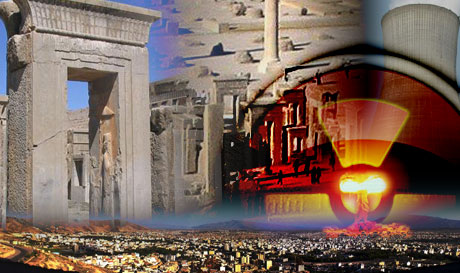Iran's priceless antiquities lie in line of fire
Source: smh.com.au

In his quiet office at the British Museum in London, among portraits of dead explorers and 3000-year-old inscriptions, one of the greatest experts on the archaeology of the Middle East has a series of maps of Iranian nuclear installations spread out across his desk.
John Curtis's maps fill him with foreboding: because they show how many of Iran's nuclear plants are perilously close to ancient cultural sites.
Natanz, home to a uranium enrichment plant, is renowned for its exquisite ceramics; Isfahan, home to a uranium conversion plant, is also a UNESCO world heritage site and was regarded in the 16th century as the most beautiful city on earth.
Other nuclear installations lie close to Shiraz, dubbed "the city of roses and nightingales" and famous for the tombs of medieval poets; Persepolis, the great palace of King Darius, whose ruins are still magnificent; and the tomb of Cyrus the Great, the Persian ruler said to have been buried in a coffin of gold.
Four years ago Dr Curtis warned that war in Iraq would be a disaster for some of the oldest and most important sites in the world. He has since seen his worst fears confirmed: the site of ancient Babylon became a US military base; thousands of objects are missing from the national museum in Baghdad; and looted artefacts have been illicitly excavated and smuggled out of the country.
Now Dr Curtis dreads seeing history repeated, this time from the escalating threat from the US against Iran. "Any kind of military activity whatever in Iran, whether aerial bombing or land invasion, would inevitably have the gravest consequences, not only for its people but for its cultural heritage, which should be a matter of concern not just to Iranians but to the whole world," he said.
"The main nuclear bases would seem the most likely targets, which would directly threaten two major sites, Isfahan and Natanz." The medieval splendour of those cities, at the height of the power of Islamic Persia from the 13th to the 17th centuries, was built on a cultural history which was already thousands of years old.
The history of cities, of writing, of engineering and astronomy began in the ancient centres of Iran and Iraq. "The archaeology is so rich there is almost nowhere that you could say is devoid of interest," Dr Curtis said. "But certainly a list must be compiled of the sites which need the most consideration."
Unlike the looted and still shuttered national museum in Baghdad, in Iran the risk is considered less for the national museum in Tehran than for hundreds of major sites with standing buildings and ruins, and thousands of known but unexcavated sites.
Some of the structures are in stone, but most are in baked brick with elaborate tile decorations, a building type particularly vulnerable to blast damage.
Apart from Isfahan and Natanz, other potentially vulnerable sites cover 3000 years of the world's history.
Professor Harriet Crawford, of the Institute of Archaeology in London, said: "An attack on Iran would not only cause thousands more avoidable deaths, but would also risk inflicting untold damage on its heritage, comparable with that seen in Iraq."
Article from: http://www.smh.com.au/news/world/irans
-priceless-antiquities-lie-in-line-of-
fire/2007/03/05/1172943356478.html






















